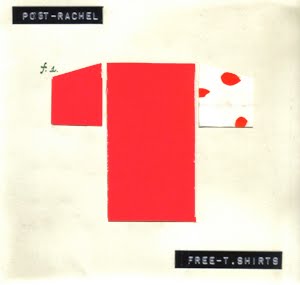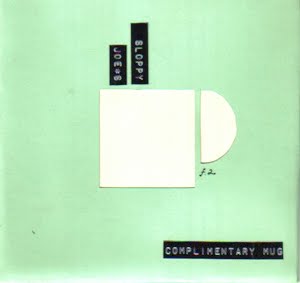
1. Means and Ends
What does it take to be my favorite episode of Tom & Jerry? Something situational--like company or inside jokes, shared laughter. It's just funny--a russian blue in a zoot suit sweet talking a prissy pussy. Tom & Jerry successfully communicated to me and my sister--eliciting a certain response (in this case laughter) usually reserved for real life experience. Gee, I thought, this is one smooth cat. My uncle wore a zoot suit to his prom some 60 years post-hoc. I'm not sure what to make of it--I thought it was cool when I saw the cut. But I doubt he got laid.
Is this art? Sure. Where does it place the artist? It is, after all,
A Metro Goldwyn Mayer cartoon
I wonder if modern art has become Jeff Koons and Damien Hirst. Both have effectively robbed Duchamp of his ready-made power. These are two "artists" who've effectively paid to make their product. The argument is that the concept is their own, regardless of the methodology.
They, as "artists", embody the mordant commodity/consumer relationship. So empowered by the idea of their idea that they no longer need invest a personal energy. Hirst did not personally fish the shark for his "The Physical Impossibility of Death in the Mind of Someone Living" and Jeff Koons is proudly photographed over his sweatshop of painters and metalworkers.
Without a doubt, they are artists--brilliant conceptualists. But they push the collective notion of art (driven by those willing to purchase and/or admire the individual pieces) into a state of moratorium. By now we should know--the process is just as important as the concept. Assuming time as a linear concept, imagine the Caves of Altamira as the original embodiment of the process and imagine Duchamp as having freed the concept. Now, as we begin to commonly associate time and space as a singular entity, we can see the process and the concept as one.
I imagine Koons employs some hundreds to complete his pieces and thats a lovely idea in times of recession, but has it come down to business? Is the modern artist also a maven of marketing and business savvy? Jay-Z would certainly have you believe so. I enjoyed staring at Hirst's piscine opus--but in my mind I thought "this guy is such a fucking hack". You can lump Warhol in with this class of pop artist; even Dali (Koons was a big fan) who designed the Chupa Chups logo. These are artists who enjoy the dollar.
Media has made commodity of public persona. Artist, chef, musician, designer--you can always expect a posthumous movie or anthology. Their concepts are purely aesthetic--Are they making art or commercials promoting themselves? Before you make a judgment look up the works of Jeff Koons, Mona Hatoum, Jay-Z (yes...) Hirst, Warhol, etc. Try to find, view or listen to their "work" firsthand. Is it art or cult of personality? Can it be both?
2. Moratorium
As something of a post-script, we often muse on a label for contemporary art. If all things promoted as art are in fact considered art--then there is no need for label. It is emblematic of the world we live in. The lines have been blurred in the supposedly post-racial world. Art is art and it's now.

.jpg)
.jpg)
.jpg)
.jpg)
.jpg)


10 comments:
Is Fantasia art or a commodity? As a commodity (Disney's intention), it failed; as art it forever changed the face of cel animation.
I wonder what conversations took place amid artists in the 1930s regarding the m
commoditization of art at the hands of Disney and those who followed.
Disney, Hanna, Barbera et. al. made a hell of a lot of money, and no small amount of utter crap. (I'm referring to the men themselves, not their corporations.) It's the utter crap that is fading, thankfully, from view (gradually). The art remains.
If Koons and Hirst are guilty of making money, that makes them capitalists; it will be a generation, however, before it'll be easy to judge what of their output is art, and what is ... well, let's just say output.
haha "output"--thats a good designation for it.
Fantasia is a great example.
Last night though I thought of the more traditional relationship between artist and patron. The artist creates, the patron discovers. Both artist and patron spend a good portion of their lives waiting for each other.
Koons, at least, has assumed the role of both artist and patron. I admire that DIY mentality.
I stumbled over here from a twitter search.
If it is 'bad' or 'selling out' for Jeff Koons, Damien Hirst, Andy Warhol, Takashi Murakami, etc. to be making a lot of money, we are guilty of the same crime for questioning their work BECAUSE they make a lot of money. In both cases, money is put above art, so all automatically default. As said, the art gestures will last forever...the money will be spent, distributed, and disappear...vaguely remembered.
Toulouse Lautrec's advertisements are in art history books forever. What he made for posters/ads was cutting edge...unlike the Dali example. So here, the success is judged by nothing else than how good the art or work was. As said before, that is what lasts.
Sean Daley of Atmosphere said, "the moment you sell one CD, you're a sell out. You've exchanged your art for a dollar amount. Get over it and get back to work."
Jeff Koons is the contemporary Rubens. Indeed, in classical painting the master often gave a sketch or reference to studio members and they executed it. Jeff Koons pulls from almost every art movement and he also pulls from they way art in history was made. He embodies what is post-modern. He is everything, his work is everything.
Damien Hirst's work is not as good as Jeff Koons. The shark is a spectacle, perhaps he will be remembered for it. For the skull also. But I think Damien Hirst will fade a little, maybe a lot.
Is it art or cult of personality? I don't know if I understand...but every artist and every art work is product of its environment, its heritage, its time, its economy, its intelligence, its viewers, its illusion. I think the two might be inseparable if I even grasp what 'cult of personality' means.
-K
If the name of the artist supersedes the body of work--it has become a cult of personality.
Dali.
Koons.
Murakami.
Lautrec as a designer and painter was phenomenal, but how do we judge this comparatively? It's all subjective.
What I'm looking at here is not an issue with any of the artists specifically. This is not a question of selling out. This is a musing on something more abstract--the artist's personal investment. Does it come through in their work... in Hirst's...In Koons's statues?
no.
Ogling the shark is not the same as looking at "the blind man's meal" Great artwork should leave the viewer with something. There is no right and wrong in judging...but Koons (while brilliant, and no less artistic for his execution of ideas) lacks a certain emotional gravity than a 5 year old can possess in finger paint.
Final point: we live in a world where technology is crucial to our survival. I like artists who are unafraid to use technology in creating their art. Such tech opens the door for an integration of math, science, design, architecture and creativity. But again--the technical brilliance doesn't equate to a universal chord. We can all understand "the blind man's meal" and be moved by its empathic power.
Ok, so with cult of personality being that...
Do you not think Picasso suffers the same thing? Many artists/critics/historians do not think his work was successful later in his life...but he was/is still 'Picasso'.
The world of the artist celebrity is firmly in place. Popularity and charm factored in to the way we saw things in elementary school, and growing up is hard to do.
Hmmm. A matter of the artist's personal investment...I would hazard to say that a case of 'cult of personality' over artistic merit, where the artist is why the work is accepted and not the work itself, might exemplify artist's personal investment. For instance, Jeff Koons no longer belongs to himself. Jeff Koons is the artist Jeff Koons, is his art, he belongs to us as much as his work does.
And if it's all subjective, no right or wrong, then you can't say the shark is not the same as the blind man's meal. To some it might be...we look at the painting and do not understand blindness. We try to imagine it, sympathize, empathize. We look at the shark and do not understand death. We try to imagine it, sympathize....They could be the same, it is subjective.
Confession time: The equilibrium series resonate with me (among a few others of Koons works).
I look at the basketball and am moved. That basketball has obtained something I only strive for...perfect balance, equilibrium. I fail. It has succeeded. And that relationship between understanding, not understanding, and desperately wanting to understand makes it work, makes it meaningful and full of narrative.
It does not matter to me that the artist behind it is as much a product as his work.
-K
You bring up some excellent points. In my own bias I never thought to compare the shark with the blind man--they are very similar conceptually.
You're right. It shouldn't matter the artist. Although, one's final feeling of a piece on display is a musing on both the art and artist that created it. It's almost like looking at the world and wondering what God must have been thinking (to use a simple analogy)
So you see Koons' pieces (which I enjoy for the most part) and you wonder, what was Koons thinking? Then you get the opportunity to ask him and he tells you--blah blah blah.
and the initial illusions are gone. Perhaps a new set of illusions are created. Modern art can be interpreted through the Frankfurt School. The openness of our freedom with the piece allows for doubt and confusion. We try to place the piece in some way, but we can't and what results is question/confusion/interpretation. Who do you seek for an answer to your question? You may interpret it as you will (freedom) or you can seek the creator.
You have chosen to appreciate the piece for the initial response it elicits in you. Most would rather not be left to their own devices. I'm on something of a tangent, but to bring it back...
the artist, if you care to discover him/her, is thought of as agreeable when there is a shared perspective. It's very natural to want the "creator" to be in your own "image" or "likeness" because that gives your life (and the art you're viewing) some special credence.
What I like about Koons, Duchamp, Larry Weiner, Jenny Holzer, etc...is their awareness of this idea. Most pay admission for spectacle/entertainment--what these artists have done is put mirrors on display. The viewer enters a funhouse; their reflections are warped and for many this can be an unpleasant experience.
When I looked in the mirror I thought. Hirst sucks, but i like aquariums (it was pleasing in some sense)...I thought Koons is an asshole, because he's rich and his pieces reflect affluence in many ways-But I admired the pieces, perhaps because I long to be rich.
Indeed! I have been away...sorry. But now that I have come back there are wonderful things and we have found our digital middle ground! : )
I do see Koons as you said...blah, blah, blah...he always says the right thing and he is full of words that most swallow and are satisfied with. I ignore most of his talk, I think most of it is very staged...and empty. Like seriously, how many times will the guy say 'acceptance' over his career. I wish I could ban it from his mouth....he would have nothing to say. But perhaps I think this because it is the only way I can understand Jeff Koons as an artist, to think of him more as performer when he speaks. He has perfected postmodernism and for that, I salute him but then also get irritated because I want more.
And on postmodernism...I think that is why there is this problem with being right, or wrong, or confused, or wait, what did the artist say about it....etc. Unlike in the past we have gotten rid of all right and all wrong and now we don't know where to go. There is only, I like this or I don't like this. And then the postmodern in us wakes up and makes us doubt ourselves because there is no truth, all it truth. We live in complicated times.
Ha, and to close on good terms, I cannot forgive Hirst for the Virgin Mother incident...or a lot of his work for that matter. Hirst, most of the time, does indeed suck. ; )
-K
I started to get worried haha. It got a bit quiet.
I find that weaving this idea into poetry elicits a similar response in most people. Some will say they truly enjoy piecing through the words to come to their own conclusion--but most seem to dismiss it because it is both postmodern, ambiguous and a text. While typography has come a long way as legitimate art--it's still homework for most people.
thoughts?
Hmm. Tricky. and complete opinion, but what isn't really.
Yes, I think most people do find forming their own opinion difficult because the rest of the world works so hard to decide it for them before they even have the first inkling of a thought. It is easier not to try, not to think, not to figure it out.
Take news media for example. So cliche' to use it, but it's true that the media chooses words to describe circumstances that lead the public toward one side of the fence.
Same with advertising. Like these insurance commercials lately, "You can't afford to risk it" since we're in this depression/recession/regression/i give up-ession. So what they're saying is "you can't afford to not spend money on insurance." Wait, what?
Ugh! Or audio-guides and wall texts in museums! That is the perfect example. The people flock to the wall texts or drone around with the headphones consuming not the challenge an artwork presents, but the solutions presented by other people. Other people's opinions. Then they eat those opinions and adopt them as their own.
This applies to everything. If you're legit, you read the more obscure stuff like cummings, and Rilke, Ted Hughes. You don't read Nicholas Sparks, you read Kerouac, Cortazar, Goethe, Henry Miller, etc. Radiohead instead of Coldplay. Mac not PC. Hate Jeff Koons, hate Damien Hirst, hate Shepard Fairey. But these aren't unique points of view, they just pretend to be. The groups are formed so that we can feel justified in the decisions that make us who we are. We need the box much as we like to think we are outside of it.
So that was a little off topic, but yeah...it is work to deal with the questions, especially when everywhere there are answers to pacify us. But I think we want/need the pacifiers....labels and boxes and answers make questions seem smaller. Make questions easier to deal with and then dismiss.
-K
Heavy.
K, shoot me an e-mail at drinthiscola@gmail.com
I'd like the open correspondence. The conversation is pretty cathartic
-drew
Post a Comment